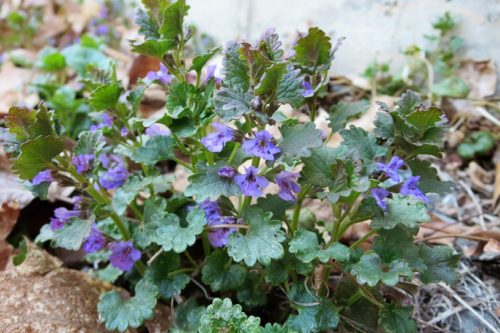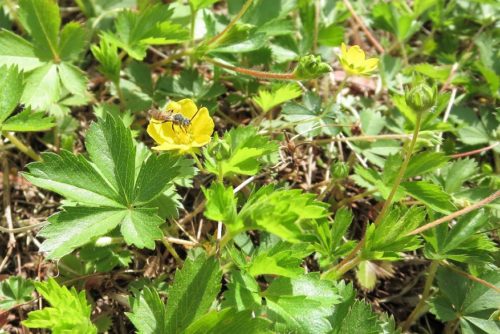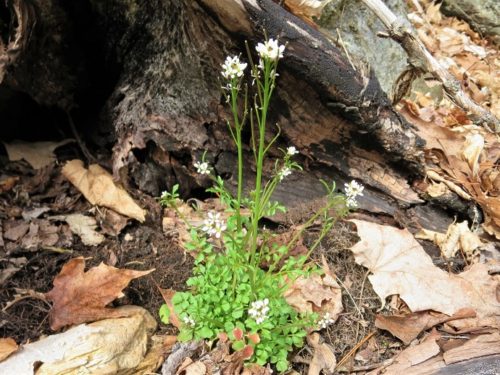Many of the plants in my yard are aggressive spreaders, and I often characterize them as battling one another for dominance, especially as new plants arrive and join the fray. But there don’t seem to be any major losers in this battle so far. Most of the existing plants have either held their ground or moved themselves to less contested areas. I wouldn’t have thought plants could move themselves, but they do. The small white violets, for example, have shifted themselves from the back yard to the side yard.
Over time, some of the weedier plants have won me over somewhat. Ground ivy, for example, is aggressive and non-native, but it’s also attractively colored and bee-friendly. And, because ground ivy grew in my parents’ yard, it reminds me of home, especially when it is freshly mown (it has its own distinctive, earthy smell). I realized quickly the futility of trying to eradicate it, and perhaps the inevitability of its presence here helped me to get over any dismay I felt over its invasive tendencies.

But there are also some plants that I’ve come to like less over time. Dwarf cinquefoil is a native plant, said to be popular with the insects, and it grows in poor soil. It also has cheerful yellow flowers. Those are definite pluses, and I can’t really find anything negative about it online, but I don’t find it to be a good yard plant. Every year it expands its range, butting out some of the other plants, and leaving the soil poorly protected with its low and patchy growth.

One particularly worrisome plant is hairy bittercress, an invasive import. Had I realized what it was when I first saw it, I might have managed to limit its spread, but it’s well established now. Its leaves are so low and its flower stalks so skinny that it blends into the grass, making it nearly invisible and hard to assess quantity-wise, but I would guess that it exists in every square foot of the front yard, and it’s rapidly spreading into the side yard. Every year I pull some of it out, but never enough. One day this spring I pulled a whole grocery-bag’s worth. Some of it was already seeding, and it blasted me as I pulled it (OMG, how those seeds fly!), but most of it was on the cusp, and I got to it just in time. I know it was an exercise in futility, but it made me feel better. Hairy bittercress is said to be edible, so I suppose it would be a good plant to have around during the Apocalypse. That’s about the only nice thing I have to say about it.

Here is hairy bittercress shown in its absolute best light: growing in a clump near an old stump. It looks nice, right? But, in a lawn, it’s virtually invisible and spreads unnoticed until it’s everywhere. Those things at the top that look sort of like wild rice are its seed capsules (known as “siliques”). Later they will launch the seeds like miniature cannonballs, a dispersal method known as “explosive dehiscence.” It’s really impressive, even if it’s not a good thing.
I am also troubled by the way a few of our inherited garden plants are spreading (more on that to come in a future post). I think that some of them will ultimately need to be removed. Right now I’m working on a landscaping plan for the yard. It’s a complicated task made harder by the fact that I have little gardening experience. I would like to finish the plan this year, after keeping a close eye on how the native plants behave in various parts of the yard, and begin implementing it next year. We have some beautiful native plants that would be even more beautiful if they could be convinced to grow in the right places and the right density. Perhaps it’s just a pipe dream, but it’s a good dream.
For now, I continued to be fascinated by the arrival of new plants, and I enjoy watching them try to make homes for themselves here. However troubled I may be by the aggressiveness of some, it’s heartening to see so many success stories. I don’t keep an inventory, but I think it’s likely that every type of plant that I’ve ever identified in the yard is still growing around here somewhere. They’re all survivors.

I’m currently hearing “Eye of the Tiger” in my head.